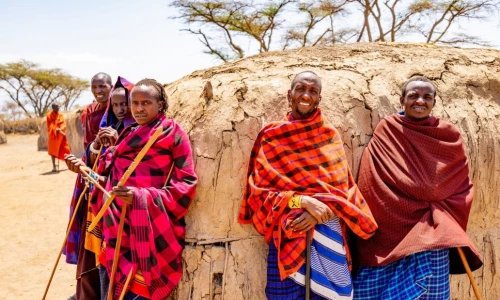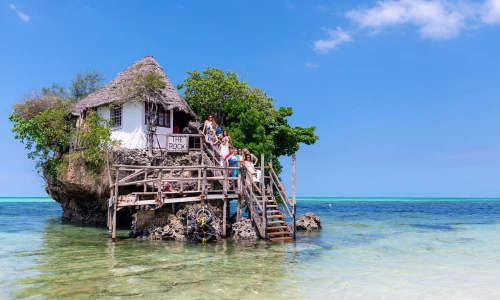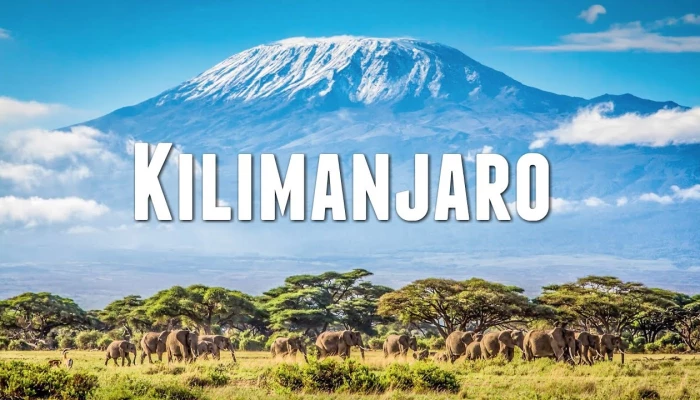Tanzania wildebeest migration
Related Articles

Tanzania Wildebeest Migration
The Great Wildebeest Migration in Africa – also known as the Gnu Migration, Serengeti Migration, and Masai Mara Migration – is one of the last m…
The Great Wildebeest Migration in Africa – also known as the Gnu Migration, Serengeti Migration, and Masai Mara Migration – is one of the last m…
The Great Wildebeest Migration in Africa – also known as the Gnu Migration, Serengeti Migration, and Masai Mara Migration – is one of the last mass terrestrial wildlife movements left on the planet. It’s why many travelers venture to Kenya and Tanzania for a Migration safari, especially around mid-year.
Migration is one of nature’s greatest paradoxes: timing is vital, but there is no way to predict the timing of the animals’ movements. We know that the wildebeest (and a smattering of zebra and antelope) will cross the Mara River – but nobody knows exactly when. We also know that rain will trigger the wildebeest to move onto fresh grazing – but nobody knows exactly when the rain will fall.
How Does the Great Migration Work?
Can the Migration River Crossings be Predicted?
No, not even the wildebeest know when they’re going to cross! Some arrive at the water and swim over immediately; some arrive and spend days hanging around grazing; some arrive and turn back to where they came from. We wish we could predict the crossings, but no one can. This is why it is best to have as much time on safari as possible if you hope to see a river crossing.
What Month is the Wildebeest Migration?
Most people think that the Wildebeest Migration only takes place between July and October, but it’s actually an ever-moving, circular migration with various but equally exciting events that occur year-round. The popular river crossings usually coincide with the safari's high season (June to October), hence the perception that this is the only time of the year that the wildebeest is on the move or can be seen.
Where Does the Great Migration Start?
Because the Great Migration is a fluid, year-round movement of about two million animals across the Serengeti-Mara ecosystem, there are no defined start or end points. The Gnu Migration is triggered by East Africa’s rains and the animals follow an age-old route in search of fresh grazing and water. This epic journey takes the wildebeest across the Masai Mara plains in Kenya, all the way south into Tanzania’s Serengeti and the edge of the Ngorongoro Crater, before circling up and around in a clockwise direction.
Why Do Wildebeest Migrate?
It is generally believed that the Great Migration in Africa is dictated primarily by the wildebeest’s response to the weather. They move after the rains and the growth of new grass, essentially following a natural instinct to find food to stay alive. Some experts believe that the wildebeest is triggered by distant lightning and thunderstorms, but there is no scientific proof of it.
What Happens When?
A Month-by-Month Breakdown of the Great Migration
With climate change, the long and short rainy seasons in Tanzania and Kenya are no longer as regular or predictable as they once were. The rains can be late or early, which will throw the whole wildebeest calendar out of synch. This is, once again, why it’s important to plan for as much time on safari as possible. You cannot fly in for two nights, see a river crossing, and fly out again – nature simply doesn’t work that way. This is a very general guideline for where the herds are during the year – bearing in mind that the entire Gnu Migration is triggered by rain, which can be early, late, or on time:
January
The herds are in Tanzania’s Serengeti National Park, moving south from the north-east region and into the area near Lake Ndutu. The Serengeti is not fenced, so the herds are free to move where they can find grazing. Remember that although up to two million wildebeest, zebra, and antelope form the Serengeti Migration, they are not all in a single herd. The animals break up into mega-herds of thousands or hundreds of individuals at a time.
February to March
It is a calving season (over 8,000 wildebeest babies are born each day!) so prepare yourself for lots of wobbly calves... and lots of heartbreak as fearsome predators swoop in. The Serengeti’s big cats take the lion’s share, but hit-and-run jackals, packs of wild dogs, and hyena clans add to the spectacle. It’s a bittersweet ballad; the circle of life played out as a live-action drama. If the short rainy season (Nov–Dec) produces good grazing, the herds feed frenziedly and remain in the Serengeti's southern plains until they slowly start moving west in March.
April
It’s the start of the long rains (Apr-May) and the herds generally move in a north-westerly direction towards the Moru and Simba Kopjes. The action-packed rutting (breeding) season is in full swing, featuring testosterone-fuelled jousts between males competing for the right to mate with receptive females.
May
Wagons roll! The massed herds are on the go, huge columns of up to 40 kilometers (25 miles) in length can sometimes be seen as the wildebeest funnel up into the central Serengeti. Everyone’s moving a little quicker now that the calves are stronger.
June
The wildebeest are usually in the central Serengeti and getting ready for the toughest part of their odyssey. The herds may have split up, with some already crossing the Grumeti River.
July
The Great Migration has reached the Grumeti region and northern parts of the Serengeti and is peering closely at the treacherous waters of the Mara River they have to cross into Kenya. Why? Huge Nile crocodiles, that's why! As mentioned, it is impossible to accurately predict river crossings – they depend entirely on the rains and the often unpredictable wildebeest themselves. It’s vital to book your Wildebeest Migration safari in Africa up to a year in advance to get a lodge on or as close to the river as possible – this cuts down on travel time to lookout points. The wildebeest do have historical crossing areas and you may spend days staked out in the hope of seeing the action. We recommend choosing a mobile safari camp that moves with the Migration to ensure you’re in the right place at the right time.
August
August is generally considered the best time to witness the dramatic river crossings from the northern Serengeti into the Masai Mara. You'll need a passport to cross into Kenya; the wildebeest are exempt. The Masai Mara National Reserve is open to members of the public so for a more exclusive safari experience, head for the private conservancies that are contiguous with the reserve.
September
The herds break up into smaller groups, as not all the wildebeest migrate into Kenya. Less than half of the animals remain in the northern Serengeti, the rest are swapping war stories in the Masai Mara. So you could still see wildebeest in the Serengeti (just not the mega-herds) but as a general rule of thumb, the Masai Mara is the best place to witness the Migration in September.
October
Your best bet is still the Masai Mara, but bear in mind it is a far smaller reserve than the Serengeti and there may be a lot of other visitors. The neighboring private conservancies are much less crowded and, not only will you still be able to witness the Migration, but you will also directly contribute to the Maasai communities who have lived there for thousands of years. Plus you can enjoy off-road game viewing, night drives, and walking safaris – activities not permitted in the national reserve.
November
In a ‘normal year,’ the short rains have begun, propelling the wildebeest to leave the now-denuded grasslands of the Masai Mara and head back into the rejuvenated Serengeti. Bear in mind that the rain can be late or early, which is also unpredictable. The herds are generally on the move but can be seen around the north-eastern parts of the Serengeti where they may split into smaller groups for their journey southward.
Tip: although many people think of Africa as a hot place, the rain can cool things down dramatically. You’ll be out on early morning and late afternoon game drives – the sun is at its weakest during these times. Take at least one pair of trousers, closed shoes that can cope with mud, and a fleece or waterproof jacket.
December
Fresh grazing sees the wildebeest move south, covering the northern and eastern Serengeti to feast and prepare for yet another death-defying, 3,000-km (1 900-mi) odyssey.
When is the Best Time to Go on a Migration Safari?
Now that you know how the Great Wildebeest Migration in Africa works, you can easily see that the best time to go depends entirely on which events you're personally interested in seeing. Remember, the Serengeti and Masai Mara’s abundance of wildlife and wide open landscapes make them fantastic year-round safari destinations.
| Event | Approximate Time | Place |
| Calving (Birthing) Season | February to March | Southern Serengeti |
| Rutting (Breeding) Season | April to May | Western & Central Serengeti |
| Grumeti River Crossings | May to June | Central Serengeti |
| Mara River Crossings | July to August | Northern Serengeti & Masai Mara |
| On the Move | November to January | Masai Mara & Northern Serengeti to Southern Serengeti |
Note: the above are approximate dates only. The Wildebeest Migration is a year-round, circular journey and the river crossings cannot be predicted. Sometimes the herds stay put for two weeks, other times they could cross four times in one day!
Key Facts to Remember
- The bulk of the Migration takes place in the Serengeti.
- It’s a year-round, circular journey.
- River crossings cannot be predicted, but generally occur between May and August.
- The animals are strung out across a large area – there are always forerunners and stragglers.
- Your best chance of seeing a river crossing may involve spending all day at a site where the wildebeest has massed. If you are a keen photographer, your best opportunities may occur around midday when the sun and glare are at their harshest, so make preparations to accommodate this.
Afrima Luxury Travel
Luxury Safari Consultant Afrima Luxury Travel is a Tanzania Expert Safari company dedicated to sharing Tanzania's beauty and wonders with the world.
Was this article helpful?
25 out of 78 found this helpfulRelated Articles

Tanzania Culture Safaris

Zanzibar Beach Holidays

Mount Meru Tanzania

Tanzania Wildebeest Migration



